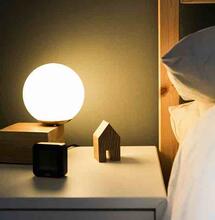Ceramic metal-halide lamps
09 Sep 2019

There is always something happening in the world of growing under artificial light. From time to time, people discover something new and special, which changes the game and brings up long-answered questions back on the table. In the following article, I am going to show you one technology that fits all the above mentioned parameters: ceramic metal-halide lamps. Is this nearly thirty years old news going to become the future of growing plants under artificial light?
 CMH lamp with one layer of glass for closed reflectors[/caption]
Currently, there are many CMH lamps available on the market, but not all of them are suitable for growing plants, and not all of them are constructed in a way that would allow for growing plants. Nonetheless, all of them are based on one of the three types of Philips lamps with power of 315W: CMD Elite Agro, CMD Elite 930 and CMD Elite 942. For growing plants, the most effective is the first one because it can transform most of the electricity into light in the area of photosynthetically active radiation. CDM Elite Agro can be used throughout the whole growing cycle. The second most effective is Elite 942 with correlated color temperature of 4200 K – it is particularly suitable for the growth stage and it has more blue light than the other two types. The best for flowering is CDM Elite 930, but it can be used for the growth stage as well. A lot of companies produce imitations of CDM Elite 930 lamps in varying quality and different light spectrum adjustments. In case you want to invest money in CMH, be especially careful when dealing with suspiciously cheap Chinese products. Choose only types with ceramic tube protected by two layers of glass. This way a part of the UV radiation is filtered, plus it means more safety for you in case there is some damage of ceramic tube installed in an open reflector. The models with only one glass layer are meant to be used with closed reflectors that have their own glass. Ceramic lights are marked as CMH (Ceramic Metal-halide), CDM (label of Philips) or LEC (Light Emitting Ceramic).
The power of 315W is not common in HID lights, but it has certain advantage – you can hang the lamp closer to your plants and spread the light more evenly. However the cost of two 315W CMH lights is much higher than one 600W HPS, and nearly the same as a good quality LED module with 400W. You can also come across CMH lights with power of 630W or 945W. These types comprise of two or three 315W CMH lamps enclosed in one tube.
[caption id="attachment_10423" align="alignnone" width="780"]
CMH lamp with one layer of glass for closed reflectors[/caption]
Currently, there are many CMH lamps available on the market, but not all of them are suitable for growing plants, and not all of them are constructed in a way that would allow for growing plants. Nonetheless, all of them are based on one of the three types of Philips lamps with power of 315W: CMD Elite Agro, CMD Elite 930 and CMD Elite 942. For growing plants, the most effective is the first one because it can transform most of the electricity into light in the area of photosynthetically active radiation. CDM Elite Agro can be used throughout the whole growing cycle. The second most effective is Elite 942 with correlated color temperature of 4200 K – it is particularly suitable for the growth stage and it has more blue light than the other two types. The best for flowering is CDM Elite 930, but it can be used for the growth stage as well. A lot of companies produce imitations of CDM Elite 930 lamps in varying quality and different light spectrum adjustments. In case you want to invest money in CMH, be especially careful when dealing with suspiciously cheap Chinese products. Choose only types with ceramic tube protected by two layers of glass. This way a part of the UV radiation is filtered, plus it means more safety for you in case there is some damage of ceramic tube installed in an open reflector. The models with only one glass layer are meant to be used with closed reflectors that have their own glass. Ceramic lights are marked as CMH (Ceramic Metal-halide), CDM (label of Philips) or LEC (Light Emitting Ceramic).
The power of 315W is not common in HID lights, but it has certain advantage – you can hang the lamp closer to your plants and spread the light more evenly. However the cost of two 315W CMH lights is much higher than one 600W HPS, and nearly the same as a good quality LED module with 400W. You can also come across CMH lights with power of 630W or 945W. These types comprise of two or three 315W CMH lamps enclosed in one tube.
[caption id="attachment_10423" align="alignnone" width="780"] Spectral curve of CMD Elite Agro 315W.[/caption]
Spectral curve of CMD Elite Agro 315W.[/caption]
 Spectral curve of Metal-halide bulb Osram Powerstar 400W.[/caption]
Spectral curve of Metal-halide bulb Osram Powerstar 400W.[/caption]
Ceramic in lamps
Those of us who believed that LED technology would quickly prevail over traditional HID lamps in the area of growing plants under artificial light will have to wait for another bit, because high-intensity discharge lamps (HID) haven’t surrendered so easily. Currently, there is a big fuss about re-discovered CMH lamps. This technology has been developed already during the early eighties by Philips. CMH lamps use the same technology as metal-halide lamps, with the difference being a substitution of quartz arc tube with ceramic arc tube, which is also used in sodium lamps. Metal-halides lamps, as their name suggests, contain metal-halides or salts, and their content and composition influences the color of emitted light spectrum. When using the ceramic arc tube, it is possible to reach much higher temperatures than with quartz glass. The temperatures are so high in fact, that quartz glass would start melting under such conditions. Since ordinary metal-halide lamps could not reach higher temperatures, the developers had only limited possibilities in terms of choosing the light spectrum. Metal-halide lamps (MH), for example, were more effective in the blue spectrum than high-pressure sodium lamps (HPS), but they were lacking in the red spectrum. This means that for growing cannabis, MH lamps are suitable only for the growth stage, or as a complementary light source. When used for flowering, the buds are sparse and the harvest is smaller. That is why we use sodium lamps for the flowering stage. For many years, CMH lamps were not suitable for growing plants, since they were not powerful enough. Only in the beginning of the new century were the developers able to build a CMH lamp with larger power output than 150W – paving way for many new uses. [caption id="attachment_10424" align="alignnone" width="780"] CMH lamp with one layer of glass for closed reflectors[/caption]
Currently, there are many CMH lamps available on the market, but not all of them are suitable for growing plants, and not all of them are constructed in a way that would allow for growing plants. Nonetheless, all of them are based on one of the three types of Philips lamps with power of 315W: CMD Elite Agro, CMD Elite 930 and CMD Elite 942. For growing plants, the most effective is the first one because it can transform most of the electricity into light in the area of photosynthetically active radiation. CDM Elite Agro can be used throughout the whole growing cycle. The second most effective is Elite 942 with correlated color temperature of 4200 K – it is particularly suitable for the growth stage and it has more blue light than the other two types. The best for flowering is CDM Elite 930, but it can be used for the growth stage as well. A lot of companies produce imitations of CDM Elite 930 lamps in varying quality and different light spectrum adjustments. In case you want to invest money in CMH, be especially careful when dealing with suspiciously cheap Chinese products. Choose only types with ceramic tube protected by two layers of glass. This way a part of the UV radiation is filtered, plus it means more safety for you in case there is some damage of ceramic tube installed in an open reflector. The models with only one glass layer are meant to be used with closed reflectors that have their own glass. Ceramic lights are marked as CMH (Ceramic Metal-halide), CDM (label of Philips) or LEC (Light Emitting Ceramic).
The power of 315W is not common in HID lights, but it has certain advantage – you can hang the lamp closer to your plants and spread the light more evenly. However the cost of two 315W CMH lights is much higher than one 600W HPS, and nearly the same as a good quality LED module with 400W. You can also come across CMH lights with power of 630W or 945W. These types comprise of two or three 315W CMH lamps enclosed in one tube.
[caption id="attachment_10423" align="alignnone" width="780"]
CMH lamp with one layer of glass for closed reflectors[/caption]
Currently, there are many CMH lamps available on the market, but not all of them are suitable for growing plants, and not all of them are constructed in a way that would allow for growing plants. Nonetheless, all of them are based on one of the three types of Philips lamps with power of 315W: CMD Elite Agro, CMD Elite 930 and CMD Elite 942. For growing plants, the most effective is the first one because it can transform most of the electricity into light in the area of photosynthetically active radiation. CDM Elite Agro can be used throughout the whole growing cycle. The second most effective is Elite 942 with correlated color temperature of 4200 K – it is particularly suitable for the growth stage and it has more blue light than the other two types. The best for flowering is CDM Elite 930, but it can be used for the growth stage as well. A lot of companies produce imitations of CDM Elite 930 lamps in varying quality and different light spectrum adjustments. In case you want to invest money in CMH, be especially careful when dealing with suspiciously cheap Chinese products. Choose only types with ceramic tube protected by two layers of glass. This way a part of the UV radiation is filtered, plus it means more safety for you in case there is some damage of ceramic tube installed in an open reflector. The models with only one glass layer are meant to be used with closed reflectors that have their own glass. Ceramic lights are marked as CMH (Ceramic Metal-halide), CDM (label of Philips) or LEC (Light Emitting Ceramic).
The power of 315W is not common in HID lights, but it has certain advantage – you can hang the lamp closer to your plants and spread the light more evenly. However the cost of two 315W CMH lights is much higher than one 600W HPS, and nearly the same as a good quality LED module with 400W. You can also come across CMH lights with power of 630W or 945W. These types comprise of two or three 315W CMH lamps enclosed in one tube.
[caption id="attachment_10423" align="alignnone" width="780"] Spectral curve of CMD Elite Agro 315W.[/caption]
Spectral curve of CMD Elite Agro 315W.[/caption]
Why try CMH?
In case you have just heard about CMH lamps for the first time, you may be wondering why substitute time-tested sodium lamps (HPS) for them? The answers are: higher effectiveness than with plasma light sources, higher content of blue light and also a moderate dose of UV-A and UV-B radiation. And it is the area of blue and UV where sodium lamps are lacking. The presence of blue light and UV radiation has profound impact on the morphology of plants, improves their stability and production of secondary metabolites, i.e. cannabinoids and terpenes. Stalks and branches are stronger, plants are stronger and harvest is richer in terms of active substances – and that is of course what most growers want. CMH lamps are great in imitating sunlight, they are more effective than MH lamps, but still a little less effective than HPS. And what about CMH lamps compared to LED? There are many different opinions in this area. When taking into account financial investment, CMH lamps are a bit cheaper option than a good quality LED source. On the other hand, the effectiveness of the transformation of electricity into photosynthetically active radiation is higher in LED technology. It means you will not be able to lower the amount and cost of used electricity when using CMH, as you would with LED. Still, the supporters of CMH technology have also some arguments against LED: In case anything in your LED source breaks down, you can expect problems with simply changing or repairing the damaged part; most likely the whole source will have to be replaced. When something breaks down in CMH system, it is easy to replace either the lamp, or reflector or ballast, making the cost of repairs much lower. One could argue that there are several LED modules available on the market with diodes divided into exchangeable sections, making the repair of such module pretty simple and cheap, too. In order to maintain a stable performance of your light source, it is advisable to change CMH lamp once a year. CMH lamp costs two- to three-times the cost of equivalent HPS lamp, and from the point of life expectancy the best choice is definitely the LED technology. Well manufactured types with proper heat sink, which takes away the heat from microchips, have lifespan of at least 50,000 working hours. This is nearly six years of constant use, almost seven and half years when used 18 hours per day, and more than eleven years when used twelve hours per day. Sodium lamps can effectively work for around 25,000 hours, which is about three years, but for optimal results they need to be changed every two years. Despite the fact that LED technology is continually evolving and its use for growing plants is more and more popular and effective, HID lamps are still at home in most indoor growing spaces. In this regard, CMH lamps are significant, because the composition of light spectrum is more suitable for growing plants than in HPS lamps, while the effectiveness and lifespan is much higher than with MH lamps. CMH lamps may be more expensive than HPS and MH lamps, but they are still cheaper than a good quality LED system. For a lot of growers, HID lamps have features that have not yet been successfully challenged by any other technology. The buds are really large and hard, and the lamps themselves manage to heat up the grow room even in areas with lower average temperatures (where one has to use external heating during winter) – in such places, the energy saving LED modules are no longer saving energy, because they produce almost no heat. The transition from HPS lamps to CMH is not so simple, though. One can use only reflector from the original setup (and even the reflector needs to be equipped with a new reduction for a special screw cap). Double-ended lamps have the same screw caps. When working with CMH lamps, one has to use different type of ballast than with HPS and MH. Some experts believe that CMH technology is a convenient complementation of existing MH and HPS light systems, not their adequate replacement. The price difference between HPS and CMH is pretty significant, and large grow-ops would hardly profit from using solely CMH lamps – also because of their relatively short lifespan. I agree with this opinion fully. In smaller and home grow rooms, however, the investment does not have to be large and there are more advantages than disadvantages. [caption id="attachment_10422" align="alignnone" width="780"] Spectral curve of Metal-halide bulb Osram Powerstar 400W.[/caption]
Spectral curve of Metal-halide bulb Osram Powerstar 400W.[/caption]



